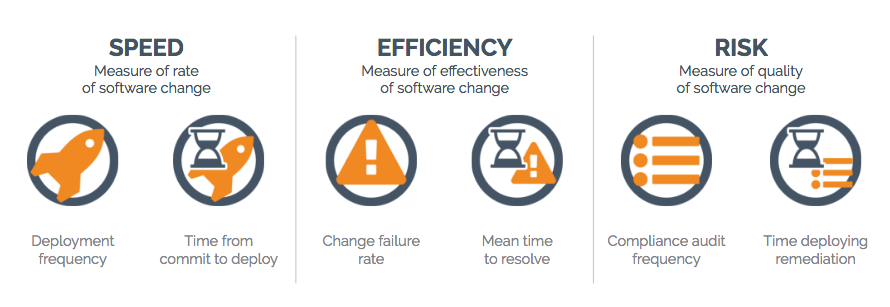Understanding Continuous Automation
High velocity companies – those that can quickly turn ideas into digital experiences for customers – use automation to get there. The concept of continuous automation is therefore generating a lot of interest. But what is continuous automation? What are the benefits? And how do you get there?
Defining Continuous Automation
Continuous Automation is the practice of automating every aspect of an application’s lifecycle to build and deploy software and changes quickly, consistently, and safely. It integrates automation of infrastructure, applications, and compliance, defining elements as code to make it easy to manage multiple versions, test for a variety of conditions, change when needed, and apply at scale. It is a sophisticated approach to building, deploying, and managing software.
But like a lot of sophisticated approaches, it’s easy to get distracted by details or organizational constraints, and miss the larger goal.
The Benefits of Continuous Automation
High velocity companies are skilled at moving software from idea to ship, repeatedly. Underlying that skill are three measurable outcomes: speed, efficiency, and risk.

The challenge, of course, is that the three outcomes naturally oppose one another. In the quest for greater speed, organizations make mistakes, introduce errors that eat away at efficiency, and increase the risk of opening security holes. What’s needed is a step-wise path to continuous automation, enabling progress on all three dimensions simultaneously.
The Path to Continuous Automation
The most successful organizations pursue continuous automation in three stages: Detect, Correct, and Automate. First, gain visibility over the current state of your infrastructure and applications to detect security risks, performance inhibitors, and areas of concern. Next, correct priority issues in order to drive outcomes. Finally, automate by building the detect-and-correct cycle into how you operate on an ongoing basis.
As you automate more of the processes involved in the application lifecycle, detect and correct happens long before issues impact your business or your customers. And that provides the confidence to truly move with velocity.
The content of this section has originally been published on https://blog.chef.io/understanding-continuous-automation.
What is continuous testing?
Continuous testing (CT) is a software development process in which applications are tested continuously throughout the entire software development life cycle (SDLC). The goal of CT is to evaluate software quality across the SDLC, providing critical feedback earlier and enabling higher-quality and faster deliveries.
What is the history of continuous testing?
In older development models (like waterfall), development activities were centered around the idea of a hand off—when one team completed its tasks, it handed the software off to the next team, keeping responsibilities and activities siloed. The justification for these separate steps was an emphasis on quality. Teams had more time to perform their specific tasks and guarantee the best result.
With demand for increased development speeds, however, this older model was no longer viable. Organizations needed a means of developing and delivering to their customers faster. A newer development model, agile, evolved to address this ever-increasing demand for development velocity. In this model, organizations introduced more incremental activities, performed continuously.
Currently, most organizations have adopted DevOps and DevSecOps, which uses an environment of collaboration and shared responsibility. This shift away from older practices has enabled teams to embrace automation and continuous activities. Continuous testing is one of these key practices.
How does continuous testing work within DevOps/ DevSecOps?
In this increasingly fast development environment, software release cycles are shortening, pushing organizations to make adjustments to their practices in order to keep up. DevOps practices and tools are essential to this success, with continuous testing playing an important role.
CT helps boost the DevOps pipeline because it fosters testing at all stages of the SDLC, from development to deployment. At the center of DevOps and DevSecOps is the idea of performing activities (like security testing) as soon as possible, speeding up all development activities. Incorporating continuous testing into this framework helps guarantee that development moves forward unhindered, and software of the highest quality is released.

What are the benefits of using continuous testing?
Continuous testing offers many benefits to the development life cycle. At a higher level, it removes the roadblocks posed by performing testing in a single step. With continuous testing, code is automatically tested as soon as it is integrated. This directly supports DevOps and the goal of delivering high-quality software, faster.
Additionally, CT helps save developer time and effort because they no longer have to wait for QA teams to finish testing before fixing their code. Instead, testing happens continuously, enabling real-time proactive fixes to code quality and security issues. Multiple activities can occur simultaneously.
A more overarching benefit of CT is that it reduces risk. With CT, software is reviewed or checked many more times and in many more ways, throughout its entire life cycle, instead of one time, during a specific phase of the SDLC. This enables more visibility into and more opportunities to discover areas of weakness.
The content of this section has originally been published on https://www.synopsys.com/glossary/what-is-continuous-testing.html
Featured Image Courtesy – Photo by Thomas Kolnowski on Unsplash



